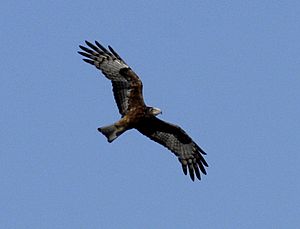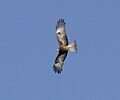Square-tailed kite facts for kids
Quick facts for kids Square-tailed kite |
|
|---|---|
 |
|
| Conservation status | |
| Scientific classification | |
| Genus: |
Lophoictinia
|
| Species: |
isura
|
The square-tailed kite (Lophoictinia isura) is a medium-sized bird of prey. It belongs to the Accipitridae family. This family also includes many other birds of prey that hunt during the day. Some examples are kites, eagles, and harriers.
Contents
About the Square-tailed Kite
The square-tailed kite was first described in 1847 by a German scientist named Johann Jakob Kaup.
All square-tailed kites look very similar. This means they are monomorphic. There are no known differences in how they look based on where they live.
What the Square-tailed Kite Looks Like
Adult square-tailed kites are medium-sized birds of prey. Here are some facts about their size:
- Length: 50–56 cm (that's about half a meter!)
- Wingspan: 130–145 cm (their wings stretch out wide!)
- Weight: Males weigh about 501 grams. Females are a bit heavier at 650 grams.
Feather Colors and Markings
Adult square-tailed kites have a white face and light-colored eyes. They have black stripes on the top of their head. Their chest also has many stripes.
The underside of their wings has a reddish-brown color. There is a dark crescent shape near the "wrist" part of their wing. Their "fingers" (the ends of their flight feathers) have bold stripes. There's also a light white patch on the underside of their wings. This patch is at the base of their main flight feathers.
The back and middle upper tail feathers are blackish. The upper tail feathers are grey-brown. They fade into a small light patch above the tail. The tail itself is square-shaped. It has a dark band near the end. Square-tailed kites have a black beak with a pink base. The waxy part above the beak, called the cere, is also pink. They have short, whitish or cream-colored legs and feet.
Their feather colors do not change with the seasons. Males and females look the same, which means they are not sexually dimorphic. Young kites look different from adults. They do not have the white face. Their head and body are a richer reddish color. They also have fewer stripes than adult birds.
It can be tricky to tell square-tailed kites apart from other similar birds. But their white face, tail shape, and overall size help identify them.
Where Square-tailed Kites Live
The square-tailed kite is a special hunter that lives mostly in tree canopies. A canopy is the top layer of leaves and branches in a forest. You can find them in many places, including:
- Open and temperate forests
- Woodlands and scrub areas
- Heathland and trees near rivers
- Savannahs (grassy plains with scattered trees)
They can also live in city areas with lots of plants, like golf courses and parks. These birds are rarely seen on the ground.
Square-tailed kites are found all over Australia. However, they are not found in large numbers in any one place. These birds usually live alone. But you might see them in pairs or with their young during breeding season. In New South Wales, nesting pairs had home areas of about 50 square meters. These nesting pairs were usually about 13 kilometers apart.
Experts believe there are between 1,000 and 10,000 square-tailed kites in total. About 67% of these birds are old enough to have babies.
Many square-tailed kites travel to different places each year. This is called migration. When and where they migrate depends on where each bird lives. Some birds do not migrate at all.
Dangers to Square-tailed Kites
The main dangers to square-tailed kites are:
- Clearing land for farms
- People illegally collecting their eggs
- Hunting
Clearing land is a big problem. When trees are removed, the kites lose places to build nests and raise their young. This makes them move to new areas. Then they have to compete for the remaining resources. This is especially true in coastal areas where new buildings are being built.
Protecting Square-tailed Kites
The IUCN Red List classifies square-tailed kites as a species of Least Concern. This means they are not currently in great danger. This is because they live in a large area. They are also spread out widely, and their numbers are stable.
However, they were once classified as Vulnerable (from 1994–1996). They also have different classifications in different Australian states:
- New South Wales: Vulnerable
- Victoria: Threatened
- South Australia: Endangered
- Queensland: Rare
Since their population is stable and they are classified as Least Concern, there are no special conservation plans just for them. But they do benefit from general environmental protections. These protections help save their habitats. Planting new trees in open or city areas also helps them.
Square-tailed Kite Behavior
How They Fly
Square-tailed kites can glide or soar. How they hold their wings changes how they fly. When gliding, their wings are held in a medium "dihedral" shape. This means their wings are slightly angled upwards, like a shallow 'V'. When soaring, their wings are held in a stronger dihedral. The tips of their main flight feathers curl upwards.
These birds are very good at flying. They use these techniques to travel in or above the tree canopy. They are almost never seen on the ground.
What They Eat and How They Hunt
Square-tailed kites hunt for food by flying slowly above or through the tree canopy. They might skim over grass or fly in straight lines.
Their diet includes:
- Smaller birds and eggs
- Small mammals like mice
- Insects
- Molluscs (like snails)
- Reptiles
They often eat young birds, such as nestlings or juveniles. They have been seen hunting crested pigeons, New Holland honeyeaters, eastern yellow robins, rufous whistlers, and young Pacific koels.
Reproduction and Life Cycle
To find a mate, square-tailed kites perform special courtship flights. These flights are like aerial acrobatics. They show off their flying skills. The male chases the female. They do aerial rolls, showing their talons (claws) but not touching. These flights might also include calls.
The breeding season for square-tailed kites depends on where they live. Kites in cooler parts of Australia breed from July to February. Those in warmer, tropical areas breed around April.
When nesting, they prefer large, tall trees in areas that have not been cleared. Both the male and female help build the nest. They might also add to old nests built by other birds. Nests can be bowl-shaped or a platform of sticks. Building a nest usually takes about three weeks.
During breeding season, the female sleeps on the nest at night. The male sleeps in a nearby tree. When there are young birds, both parents sleep near the nest. They only try to breed once each season. They lay 1 or 2 white, round or oval eggs.
The eggs hatch after about 40 days. Both parents help care for the young. This is called biparental care. The female mostly incubates (sits on) the eggs. The male hunts and brings food to the nest. However, males have also been seen incubating eggs.
The young birds stay in the nest for about 8 weeks. After they leave the nest, they depend on their parents for another two months. When they hatch, they are semi-altricial. This means they are somewhat developed but still need a lot of care. Their feathers and calls develop by about 3 weeks after hatching.
Square-tailed kites show certain behaviors before mating. These include making calls and preening each other's feathers. They also protect their territory during nesting and incubation. They make calls and fly at other birds to keep them away from their nests. When they feel threatened, they might stare at other birds with their beak open. They also raise the feathers on their head, neck, wings, and back. This makes them look bigger and more threatening.
Images for kids
See also
 In Spanish: Milano colicuadrado para niños
In Spanish: Milano colicuadrado para niños



